Is the The Official U.S. Army’s Survival Guide the quintessential guide to individual survival in the wild? What about in hostile environments? There are many survival guides marketed to preppers by various experts, but one of the best survival manuals of all might come from the U.S. Army.
In the early years of my adventures, there were many moments where if I had just had practiced a certain skill, or had knowledge on how to locate nearby resources, I would have been able to better handle the hardships I faced in wild spaces. One of the many tools I eventually learned used more were books; specifically, field and survival guides. These guides, just like their names suggest, educate and assist the reader on how to perform certain tasks or identify resources or hazards, all with the aim of helping the reader preserve their life.
The U.S. Army Survival Guide
Out of all the guides that I have handled and read through, The Official U.S. Army Survival Guide is probably one of the most unique and extensive guides I have ever read.
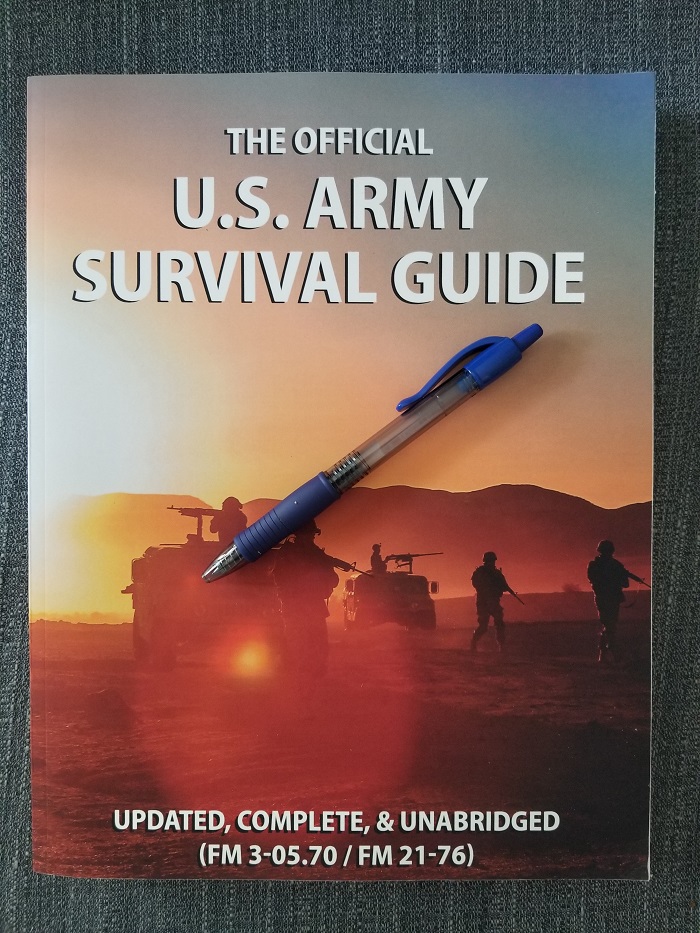
My first impressions when I thumbed through it were that this book is large, thick, massive document. This particular version from Prepper Press was better priced with a more attractive cover.
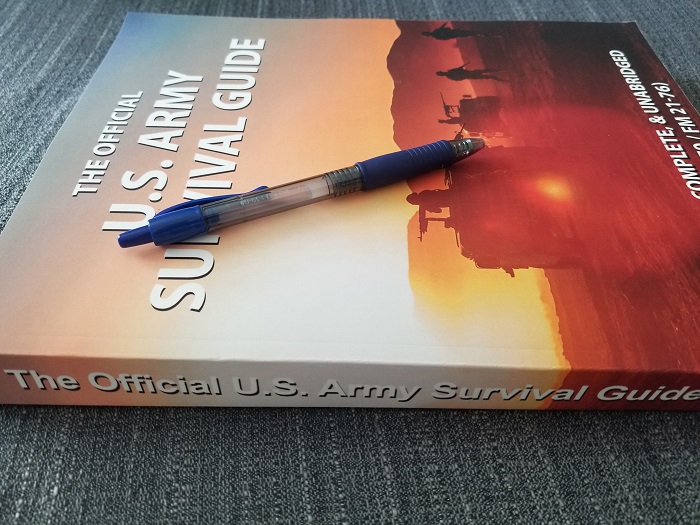
Written and developed by the U.S. Army to assist soldiers to gain the capabilities of surviving through extreme environments under hostile conditions all over the world, it is understandable why this guide is as extensive as it is.
While it may seem ridiculous for someone like your average prepper to study from a book that has so much information that may or may not even pertain to the area they live in, much of this information can be adapted and improvised on to meet individual peppers’ needs. Perhaps best of all, compared to other manuals of the same type, it is very reasonably priced!
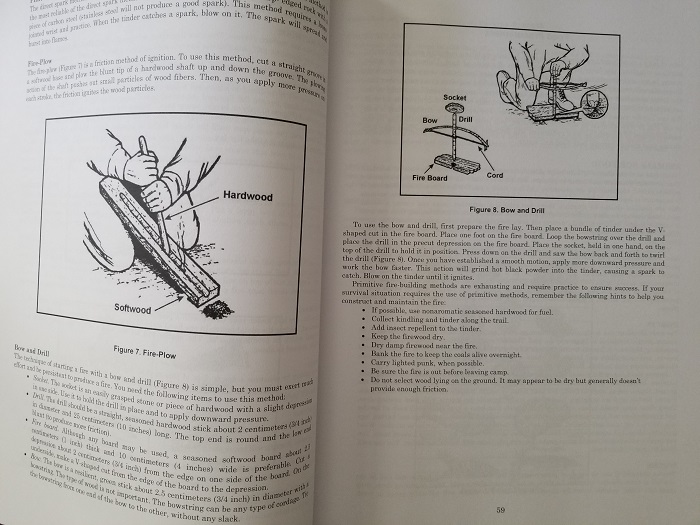
You never know quite what you will need in each situation to survive, so in the end you can never be too prepared. Reading it alone will add to your survival knowledge base, and when it comes to survival, knowledge is power.
Qualifications of a Good Survival Guide
There are a lot of guides out there. And I mean A LOT. Some of them are for specific regions of the world while others address specific aspects of surviving in unfavorable conditions. There are basic tenets of survival, but the ways to fulfill those are always changing and being improved with time and advances in understanding and technology. Survival guides are usually focused on helping the reader ensure the four most important human needs are fulfilled:
- Food
- Shelter
- Water
- First aid
While you will not be living in the lap of luxury in any scenario where you would use these skills, they will help you stay alive. That is the goal.
While any guide will be able to give you valuable information, what really sets one apart is not just the amount of information inside but how it is presented to the reader for easy consumption.
Generally, a good survival book will:
- Teach you how to fulfill your basic needs for food, shelter, and water.
- Contain plenty of specific information, tutorials, diagrams, and photographs.
- Present the information in an easy-to-understand format.
- Have information specific to your region or be generic enough to allow you to adapt to your surroundings.
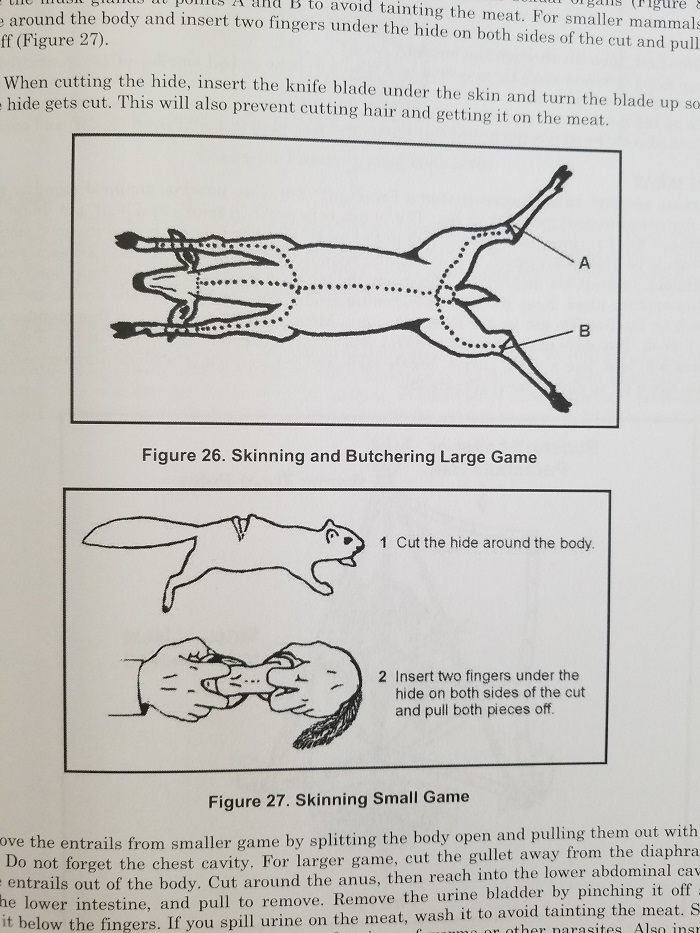
The Official U.S. Army Survival Guide absolutely fits each of these criteria. It goes above and beyond most guides that I have handled of this type. This book incorporates not only effective ways to meet the basic needs, but also extensive information on how to handle specific survival scenarios anywhere in the world.
How The Official U.S. Army Survival Manual is Different
Whereas some other wilderness survival manual or field guide will give you the basic information on how to stay alive until you are found, what this book does is tell you how to do that under hostile environments. This is particularly important for preppers, because what preppers are most often preparing for is larger-scale collapse or apocalyptic environments. This is precisely the type of situations the Army’s manual is written toward.
S.U.R.V.I.V.A.L. Basics
It should be noted that this guide is not designed to cover only the basic needs. It exceeds what the normal person would need in a survival situation. The very first pages set the stage for understanding the basics every person must know.

The way that this book shows you how to fulfill the four basic survival needs I mentioned above is through the acronym S.U.R.V.I.V.A.L. This illustrates an effective survival thought process that can be adapted to any situation that you might be in.
What Does the S.U.R.V.I.V.A.L. Acronym Stands for:
S – Size Up the Situation
U – Use All Your Senses
R – Remember Where You Are
V – Vanquish Fear and Panic
I – Improvise
V – Value Living
A – Act Like the Natives
L – Live by Your Wits
Let’s look at this acronym and what it means in more detail.
S – Size Up the Situation: This pertains to establishing what is in the surrounding area and the nearby threats, assessing your physical situation, and gaining an inventory of what equipment you have available to you. Before you can make any moves to get out of your predicament, you must know what is around you that will either impede or assist your progress.
U – Use All Your Senses: This means after you have assessed your immediate situation, you need to slow down and listen to what each of your senses is telling you. Taking the time to do this will help inform your next steps. If you move too fast you are likely to put yourself into a more dangerous situation. Being observant of each sense will slow you down enough to consider all options, know all variables, and plan out the proper steps.
R – Remember where you are: You must know your location before you can attempt to change your location to somewhere more desirable. Hopefully, you will have a map or at least a working knowledge of the direction and distance you are from safety. If you are in a group of people there needs to be at least one person who has the capability of gaining this information and passing it to the entire group, but it is still up to each person to stay oriented.
You also need to keep in mind where resources and cover are, making sure you have access to things like water and shelter to escape the elements. You cannot get to safety if you do not know where it is!
V – Vanquish Fear and Panic: Fear and panic are the greatest enemies to your survival. They hijack your mind and leave you unable to make rational decisions. You will spiral out of control and make mistake after mistake. You will panic, and panic will drain your energy and lead to more struggles. It is vital that you practice survival skills before they are needed. Practice builds confidence. Confidence crushes fear.
I – Improvise: If you have ever been up past midnight watching television, you have most likely encountered an infomercial for some novelty item that “solves” a mundane problem. This is a great example of how American consumerism leaves us inundated with more junk than we will ever truly need.
When you are caught in a survival scenario there will not be any phone you can use to order and dropship the gear and supplies you need. You will have to use the resources around you to solve your problems. From branches to pebbles, you can use your imagination and adaptability to complete the tasks needed to stay alive.
V – Value Living: One of the most important aspects of survival is the WILL to survive. If you do not value your life you may be unable to endure everything it takes to sustain it. Your personal survival in a hostile environment depends on your strength, both physical and mental. Those who do not have the mental will and fortitude will quickly fall behind others and face their own death.
A – Act Like the Natives: You will not know the area nearly as well as the people and creatures that live there their whole lives. While most of the life or death scenarios would not leave us with much time to observe fellow humans as they navigate the landscape, there can be a lot learned from the native wildlife. All living creatures have similar needs for food, water, and shelter. It only makes sense that if you were to watch them that you would be able to learn where those places are and how to use them.
L – Live by Your Wits: Your mind is the best survival tool you will ever own, but you can only exercise the skills that you know. Even if you were to bring this book with you every moment of every day, you would probably still end up failing in moments where you succeed. Even if you have a person beside you trying to teach you how to perform a task, you will still have a hard time without practice. No matter what you do, you cannot replace experience. Take the time you have now, no matter how little, and use it to gain the skills and experience to utilize your surroundings to provide for yourself. When it comes down to the moments of truth, every little bit helps.
Overall Structure of the Book
The book flows nicely from one subject to the next and builds upon the last.
Fulfilling the Basics
The two hundred pages after the initial intro are filled with diagram-rich instructions and descriptions of how to survive in any scenario, from hot climates to oceanic survival. This is the specific part of the guide where you will learn the most universal parts of how to fulfill the pattern of S.U.R.V.I.V.A.L. as well as covering the basic needs of shelter, food, and water.
This section also includes practical techniques that may or may not be known to many of the hardened and experienced preppers out there. Newer preppers just barely dipping their toes into the survival culture my find it a lot to absorb, so digest it in chunks. There were things that I had never seen or heard of that inspired me to try out during my outdoor ventures.
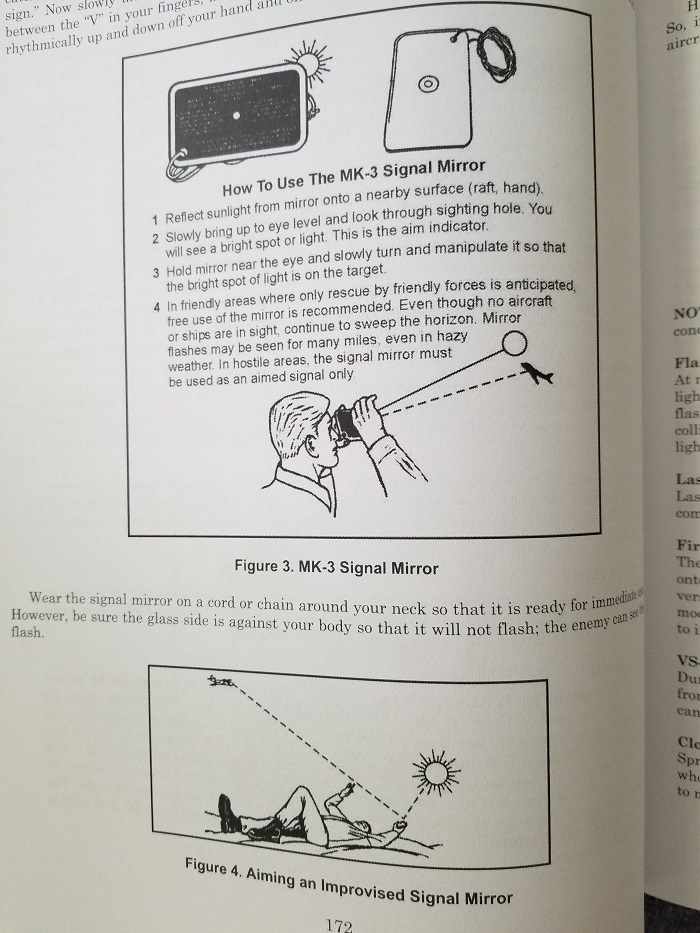
The picture above demonstrates how to use a military issue signalling mirror. Got one in your preps?
Beyond the Basics
The next two hundred and thirty-nine pages are filled with quality black and white photographs included with identification information. They begin with a large and diverse list of edible and useful plants from around the world that can aid in your survival, as well as some of the most common poisonous ones you should avoid. This section ends with a just as large and diverse list of venomous snakes that one could encounter across the world.
I particularly enjoyed thumbing through this section because I enjoy learning how to identify plants and animals, whether it is to better understand their beneficial properties or the potential threats they can pose.
The final few sections are dedicated to the basic knots you should know, how to read clouds for inclement weather, and the basic format of military evasion plans. This kind of information is crucial to be able to properly plan a way out of a scenario, so many people have lost their lives because they were plainly unaware of what resources and threats were surrounding them.
What I Did Not Like
Not all this information is going to affect you. You may never need to know how to survive in the sea, or how to identify McMahon’s Viper. I could have done without some of this information in favor of more practical survival advice in a collapse situation. That is not what this book is, however. It is a book for and by soldiers.
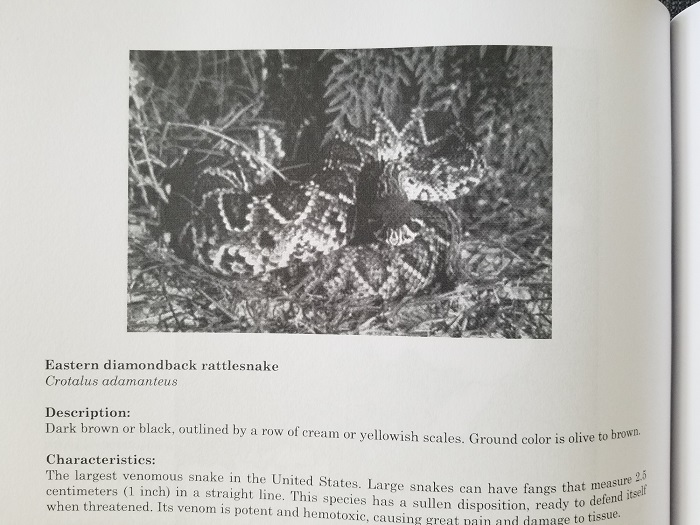
Wrapping it Up
It is easy to get sucked up into the mundane convenience and instant gratification that surrounds us and think that we will never see the day where we lose this way of life. It is called normalcy bias, and we all suffer from it to varying degrees.
I hope we are never faced with a TEOTWAWKI event, but it is naive to think that it could never happen. We got a small taste of what it could be like earlier this year with the infamous, “Toilet Paper Scare of 2020.” I felt the anxiety and paranoia with many other. I did not hoard toilet paper, but I did take stock of the situation and put my poor wife through a stressful night of panic planning. his is not the way we should go into these scenarios, especially if we want to survive. We need to do better as individuals to be prepared to face the challenges we may encounter. The Official U.S. Army Survival Guide is not the answer to all survival situations, but it is the answer to some.
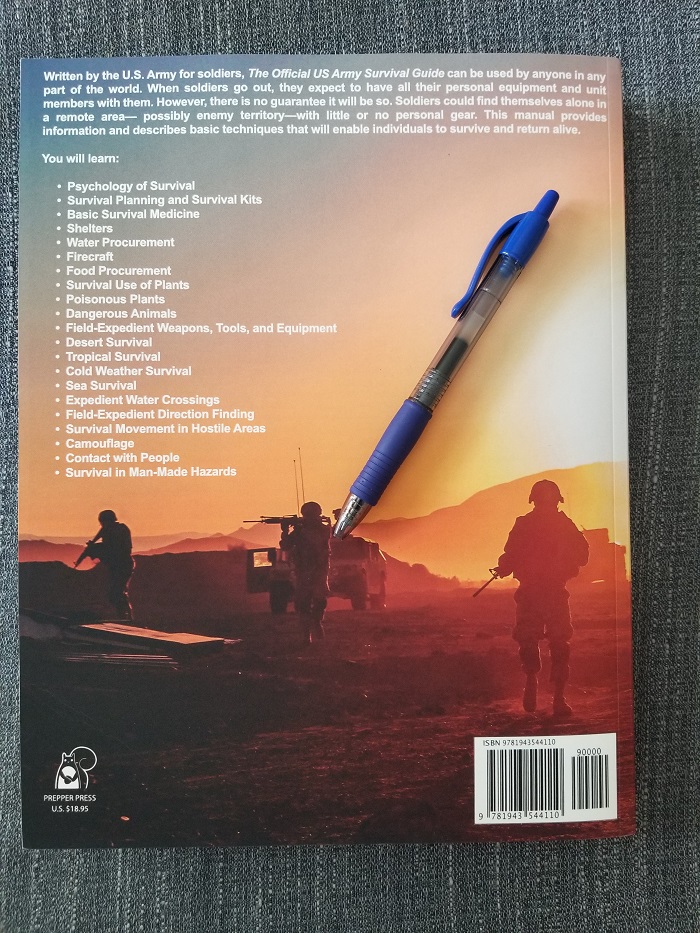
What’s the best survival guide you have read? Let me know in the comments section.
Looking for more fun reading? Check out this complete list of post-apocalyptic books.

6 comments
this is a very good book as i have one so what would YOU call THE single best survival manuel there is ??
I’m not sure I could pick just one. There is so much information to digest.
While I’m not sure I could skin a squirrel or deer, I do know I can clean a fish. But thank you for posting this. I think it’s high time I expanded my skill set by buying, reading and learning what is in this book. Then getting off my arse and DOING these things.
So thanks for posting this today.
Thanks for chiming in, Carolyn.
‘The U.S. Army Survival Guide” is a good book to have on hand. Like most ‘survival’ manuals, though, supplemental reading is needed. The British SAS(Special Air Service) survival manual is a book I would keep right beside the army survival manual. Military manuals on First Aid are also good to have on hand as they approach the topic of first aid…as the person will experience it in the field.
This book will definitely cover the basics, though I’d certainly get some additional books for more detail on a couple topics. For instance, the wild edibles, while I’m sure this book offers some great descriptions, it’s pretty important for full color pictures for proper identification. I’m sure black and white is well suited for the majority of the book, though. Definitely one for the prepper library!